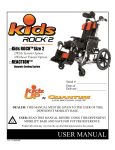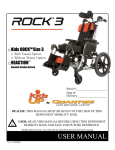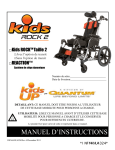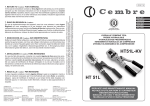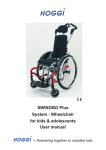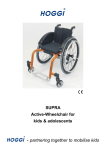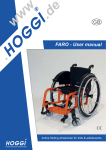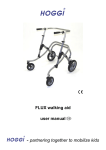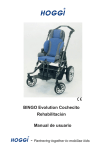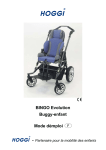Download Pride Mobility Kids up series User manual
Transcript
□Kids FAST Size 1 □With Transit Option □Without Transit Option □REACTIONTM Dynamic Seating Serial #:____________________ Date of Delivery:___________________ by DEALER: THIS MANUAL MUST BE GIVEN TO THE USER OF THIS DEPENDENT MOBILITY BASE. USER: READ THIS MANUAL BEFORE USING THIS DEPENDENT MOBILITY BASE AND SAVE FOR FUTURE REFERENCE. Product delivered may vary from the one described and pictured in this manual. USER MANUAL Ver. 11-0603DM You have made a great choice for your child by choosing a Kids FAST Chair. We believe that every child should be able to move to the best of their ability because “Movement is life.” We welcome questions and comments about our products and services. Please contact us or our distributors using the information below: Manufacturer & U.S. Distributor by Quantum Montana 312 B Andrea Drive Belgrade, MT 59714 Toll Free: 877-454-3787 www.quantumrehab.com European Distributor Your Authorized Dealer is: Partnering Together to Mobilize Kids. HOGGI, GmbH Taunusstraße 17 56235 Ransbach-Baumbach Germany Tel.: 02623 92499-0 Fax: 02623 92499-99 Website: www.hoggi.de 2 “Movement is life!” TABLE OF CONTENTS I. CHAIR MODELS & PARTS .......................................................................................... 4 II. UNPACKING YOUR NEW KIDS FAST CHAIR ....................................................... 5 III. READ BEFORE USING .............................................................................................. 6 IV. GENERAL WARNINGS ............................................................................................. 7 V. SET-UP & ADJUSTMENT ......................................................................................... 10 VI. OPERATING INSTRUCTIONS ................................................................................ 16 VII. MAINTENANCE ...................................................................................................... 28 VIII. MAINTENANCE RECORD ................................................................................... 29 3 “Movement is life!” 3 I. CHAIR MODELS & PARTS Please refer to the front of this manual to determine which configuration was delivered to you. Throughout this manual, you will notice the chair configuration option in brackets [Adjustable Seat Pan], indicating information that applies only to a specific option. The chair’s parts are labeled below for your reference. Many of the optional components are shown. Fold & Hip Angle Adjustment Sunshade Tilt Lever ACTIVE Lock Handle Handlebar Angle Adjuster Ratchet Lock Push Handle Rear Wheel Folding Trigger Calf Protector Foot Plate Caster Tire Wheel Lock The chair’s serial number label is located on the rear axle crossbar of the frame. } First four digits indicate year of manufacture. Product and labeling may vary from descriptions and pictures in this manual. 4 “Movement is life!” II. UNPACKING YOUR NEW KIDS FAST CHAIR THE ORIGINAL PACKAGE CONTAINS THE FOLLOWING COMPONENTS: Kids FAST Chair 2 Rear Wheels Additional options and accessories as ordered. PREPARING THE CHAIR FOR USE: WARNING: Contact your health care professional before using this unit with a child. 1. Remove the chair and components from the box. Keep Box Upright. Verify that package is in good shape and that no damage has occurred during shipping. Remove the Kids FAST Chair and accessories from the packaging material. Check to make sure that your order is complete. 2. Install the rear wheels (Fig. A). A. Make sure the wheel lock lever is released. B. Align the wheel with the axle on the chair. C. Press the clip on the wheel and slide the wheel onto the axle. Release the clip. D. Make sure that the wheel clip is fully engaged by pulling outward on the wheel pressing on clip. If wheel cannot be removed, clip is properly engaged. WARNING! Verify that clip is fully engaged. Figure A without 3. Fold the frame and seat back into the upright position—see section VI parts C & K for detailed instructions. 4. Install the calf protector as shown in figures B and C. 5. Make additional adjustments to the chair as necessary. Refer to the appropriate section of this manual for instructions. Figure B: Calf Protector Installation Figure C Please see the next page of this manual. 5 “Movement is life!” 5 III. READ BEFORE USING A. READ MANUAL CAREFULLY & OFTEN Read manual completely before use! Familiarize yourself with handling and functions of the product before use and practice them. You must read and fully understand the contents of this manual. Any caregiver that is going to operate this chair should also read the manual in its entirety. You are responsible for the safety of your child. The safety of your child could be affected if you do not follow the instructions in this manual. Nevertheless, not all possible circumstances and unpredictable situations can be covered by this manual. Reason, care, and circumspection are not features of the product, they are required of persons who use the product. If instructions are not clear and further explanation is necessary, please contact your Kids Up dealer. If you do not follow all instructions and warnings, damage to the chair or serious injury may occur. B. DEFINITION OF SYMBOLS WARNING! The word “WARNING” and/or the symbol shown to the left indicate practices that are unsafe or dangerous and could result in serious injury or death to the occupant of this chair or others. WARNING! READ INSTRUCTION MANUAL! Additional symbols are defined throughout this manual along with operating instructions. C. CHOOSE THE RIGHT CHAIR & SAFETY OPTIONS There are several options available to meet the needs of children. Make sure that your (and your health care provider’s) choice of chair and other options takes into account your child’s comfort, positioning, physical limitations, and hazards that may be encountered during daily use. Operating the pushchair outside of the recommendations provided by the manufacturer can lead to a dangerous situation. The pushchair is not suitable for jogging, running, skating or similar activities. Swiveling front wheels tend to wobble at higher speed and can cause a sudden stop and tip over of the pushchair. Use the pushchair only at regular walking speed. Under no circumstance should you let go of the handlebar while pushing. Do not ever push the chair away. 6 “Movement is life!” IV. GENERAL WARNINGS WARNING: The operator/caregiver must read and understand this manual prior to operating this equipment. If you are unable to understand any part of the manual, contact your dealer for assistance. WARNING: The initial set up of this pushchair must be performed by a qualified technician. WARNING: Procedures other than those described in this manual must be performed by a qualified technician. WARNING: MAXIMUM WEIGHT LIMIT The weight carried by the Kids FAST SIZE 1 chair must NEVER exceed the total weight limit of 80 pounds. (Maximum occupant size plus any items carried.) When using the chair in transit, all items including positioning tray must be removed from the chair and secured separately. WARNING: REDUCING THE RISK OF AN ACCIDENT ALWAYS get properly trained and get comfortable operating the chair. ALWAYS watch for obstacles and avoid them as often as possible. Make sure that the chair operates properly. Repair any problems before use. ALWAYS verify that the quick release clips are locked so that the back wheels do not come off. ALWAYS secure your child into the chair with the appropriate positioning components. WARNING: CHANGES & ADJUSTMENTS Adjustments made to the chair will change the balance and function of the chair and may increase risk of tip over — consult your supplier before making adjustments. Warranty will be voided if modifications that change the structure of the chair are made without authorization. WARNING: Avoid getting the chair wet as it may cause rust or corrosion. Dry the chair thoroughly if it is exposed to moisture. WARNING: EXTREME TEMPERATURES Do not leave the chair or child in the sun or near other heat sources since the surfaces on the chair may reach temperatures capable of burning the child. Do not leave the chair or child outside in cold temperatures because contact with a chair in temperatures below freezing could result in injury. Damage to the chair may also result from exposure to extreme hot or cold temperatures. 7 “Movement is life!” 7 WARNING: The chair should only be used on solid, level ground. WARNING: Use chair as intended by manufacturer. For instance, do not drive into obstacles (including curbs and steps) without slowing down. WARNING: To clear obstacles such as curbs and steps, tilt the chair onto the rear wheels. Pull it backwards to go up. To descend, slowly lower it forward. WARNING: Do not go up or down stairs without the assistance of another person. If devices such as ramps or elevators are available, please use them. If they are not available, then the chair should be carried over the obstacle by two people. WARNING: Pay particular attention when on slopes and inclines to prevent: The child from falling out of the chair; The chair from tipping over; The chair from rolling away. WARNING: Before leaving the chair and before getting into and out of it, always engage the wheel locks. WARNING: Do not stand on the footplate when getting into or out of the chair. WARNING: LIFTING—Only lift the chair by parts that are solidly attached. The chair should be lifted by the side frame members whenever possible. If folded, hold the chair by the lower side frame tubes. If the shell is in the frame, do not tip the unit to the side or upside down because the shell could release from the frame and cause injury. Always use two people to prevent injury and damage to the chair. Engage wheel locks before transferring the child to or from the chair! WARNING: When your child reaches for objects in front, to the side, or behind the chair, be sure that they do not lean out of the chair too far since the shift in the center of gravity might cause the chair to tilt or tip over. WARNING: The handling of the chair is influenced by tire pressure. Correctly inflated tires considerably improve its maneuverability. The air pressure should be at least 29 PSI. 8 “Movement is life!” WARNING: Please be aware that with certain footrest settings the footrest can collide with the front casters. WARNING: Please keep packaging material away from children. Plastic packaging presents the danger of suffocation. WARNING: Never leave your child unattended in the chair even when they are strapped in and the wheel locks are engaged. WARNING: The chair is only intended to carry one child at a time. Do not carry more than one child at a time. WARNING: Whenever you change a setting on the chair, make sure that you firmly tighten any screws that have been loosened. WARNING: MOTOR VEHICLE SAFETY The front cover of this manual indicates whether your chair has the transit option installed. If your chair is not equipped with the transit option, do not use it as a seat in a motor vehicle. Transfer the child from the chair to an approved motor vehicle seat. If your chair is equipped with the transit option, refer to the section in this manual regarding use of this chair for transit. ** The shell alone should never be used as a child seat in a motor vehicle. *** Although the Kids FAST chair can be folded into a single compact unit with the shell installed, it is possible that the shell can become detached from the mobility base. When loaded into a motor vehicle always ensure that the shell assembly and the frame are properly secured. WARNING: Never use this chair on an escalator because the chair may tip over. WARNING: The chair must be inspected and maintained per the chart in section VII: Maintenance. Problems detected must be repaired before the chair is used. WARNING: Many of the screws, bolts, and nuts used on this chair are specialized or high-strength fasteners. Only use fasteners purchased through an authorized supplier. WARNING: Do not put excessive force on the handlebar. 9 “Movement is life!” 9 V. SET-UP & ADJUSTMENT Tools Required: 5/32” Hex Wrench 3/16” Hex Wrench 2—1/8” Hex Wrenches 7/16” Nut Driver A. SEAT DEPTH ADJUSTMENT To achieve proper seat depth, it may be necessary to adjust the position of the back canes. B Seat depths shorter than 7.5 inches - back canes must be installed in position 1. Seat depths between 7.5 and 9.5 inches - back canes should be installed in position 2. Seat depths greater than 9.5 inches - back canes should be installed in position 3. Adjusting back cane position: 1. Remove shell from mobility base as shown on page 22. Remove back and seat cushions. 2. Using a 5/32” hex wrench, remove bolts for lower back plate [A] and bolts for back cane [B]. Repeat on opposite side. 3. Adjust back canes/lower back plate to desired position. Reinstall bolts and tighten. 4. Reinstall cushions and install shell into mobility base. Adjusting seat depth: 1. Detach hook and loop flap on rear of seat cushion. 2. Loosen the adjustment knob [C] below the seat pan. 3. Loosen any accessories that prevent the seat pan from sliding. 4. Push or pull on the front of the seat, evenly on both sides, until the seat reaches the desired depth. 5. Tighten the adjustment knob [C] and any accessories loosened in step 4. A Figure 1: Back Cane Adjustment C Figure 2: Seat Depth Adjustment 10 “Movement is life!” B. GLIDE REST ADJUSTMENT To allow optimal active function, it may be necessary to adjust glide rests. For seat depths 10” or less,* glide rests must be installed in position 1. For seat depths 10” or greater, glide rests can be installed in position 2. This will enable a stronger return to the upright position from the extension position. Figure 3: Position 1 Adjusting Glide Rests: 1. Remove seat cushion. 2. Remove seat depth adjustment knob (Fig. 2). 3. Remove lower shell assembly from upper shell. 4. Using a 5/32” hex wrench, remove bolts. 5. Install glide rests in desired position and tighten bolts. 6. Repeat on opposite side. 7. Reinstall lower shell, seat depth adjustment knob, and cushion *Measured from front of back cushion to edge of seat cushion. Figure 3a: Position 2 C. BACK HEIGHT ADJUSTMENT 1. Loosen the back plate adjustment knob [A]. 2. Loosen the laterals and other items attached to the back as necessary. 3. Slide the back to the desired position. 4. Tighten knob and check for proper position of all items loosened in steps 1-2. A Figure 3b: Back Height Adjustment D. LEG LENGTH ADJUSTMENT 1. Use a 5/32” hex wrench to loosen the 2 bolts [A] in each adjustment block (Fig. 4). 2. Adjust the leg length to the desired position. 3. Tighten the bolts [A]. A WARNING: some footrest settings can cause the footrest to collide with the front casters. Figure 4: Leg Length Adjustment 11 “Movement is life!” 11 E. SHORT LEG DROP ADJUSTMENT—For shorter leg length adjustment, it is possible to mount the foot bed upside-down. 1. Remove pivot plate adjustment bolt [A] with a 3/16” hex wrench. Using a 7/16” nut driver and 5/32” hex wrench remove foot bed pivot bolt [B] (Fig. 5). 2. Using a 5/32” hex wrench, remove pivot plates [C] from footrest extensions [D] (Fig. 6). 3. Flip pivot plates upside down and attach to opposite footrest extensions making sure that T-nut in counter-bored hole is bolted to upper hole in footrest extension (Fig. 7). 4. Reinstall foot bed upside-down with pivot bolt through the lower hole of the extension (Fig. 8). 5. Adjust desired leg drop, tighten leg length adjustment bolts. Reinstall pivot plate adjustment bolts. D B A Figure 5: Footrest Assembly: Standard Leg Drop C Figure 6: Standard Leg Drop Configuration Figure 7: Short Leg Drop Configuration Figure 8: Footrest Assembly: Short Leg Drop F. ADJUSTING THE POSITION OF THE HIP GUIDES (ADDUCTORS) OR ARMRESTS/HIP GUIDES Slotted adductor brackets should always be adjusted as far apart as possible. This will allow the seat cushion to be properly installed. Adductor pads can be adjusted to accommodate a wide range of hip widths by adding or removing layers of 1/4” foam from the pad cover. Extra wide adductor covers are available. Figure 9: Adductor Figure 10: Adductor/armrests 12 “Movement is life!” G. INSTALLATION OF PELVIC POSITIONING BELTS • • Attachment Locations The child should always be secured in the chair with a positioning belt. Positioning belts should never be used for securement in motor vehicles. An additional automotive rated seat belt is required. Remove the seat cushion. Fig. 11 shows the attachment chafes to which a pelvic positioning belt may be attached. 3. Attach the belt according to the manufacturers instructions. 4. Set the seat cushion back in place. 1. 2. Figure 11: Pos. Belt Attachment Locations WARNING: Positioning belts should never be used for securement in motor vehicles. The chair does not ship equipped with a WC-19 compliant belt. An additional WC-19 compliant automotive type seat belt is required when the chair is used in vehicles. H. SUNSHADE INSTALLATION AND REMOVAL C A B 1. To install the sunshade, align the sunshade tubes [A] with the sunshade mounts [B] on the rear of the upper back plate. Push tubes into mounts until block [C] contacts mount. 2. Secure sunshade to chair by turning knob [D] clockwise until tight. Do not over-tighten. 3. To remove sunshade, turn securement knobs counterclockwise and lift sunshade out of mounts. Figure 12: Align sunshade tubes with sunshade mounts D Figure 13: Tighten knob to secure sunshade 13 “Movement is life!” 13 I. EXTENSION LIMIT AND FORCE ADJUSTMENT 1. 2. 3. 4. Engage wheel locks. B Remove the child from the chair. Remove shell assembly from mobility base—see page 22. Using two 1/8” hex wrenches, hold the spring securement A bolt on the outside of the seat base and turn inner bolt [A] counterclockwise. Remove bolt and washer. Remove existing spring. Install new spring. Be sure that end of spring hooks through the side plate [B]. Reference opposite side spring to verify proper installation. Reinstall bolt and washer. Tighten until bolts bottom out in threads. Check for smooth resistance. If spring binds, it may be necessary to loosen bolt [A] in 1/4 turn increments until Figure 14: Extension Force Spring located in seat base action is smooth. side plate. Note location of spring hook [B]. Repeat procedure on opposite side. Chair will not function properly unless springs are identical from side to side. Reinstall shell assembly and test function of extension force springs. 5. 6. 7. 8. 9. 10. Figure 15: Changing Extension Force Spring 14 “Movement is life!” J. EXTENSION LIMIT AND FORCE ADJUSTMENT [Reaction Active Leg Rest Only] 1. Remove the calf protector to expose the lower end of the knee angle tensioning device. 2. Slide the triangular plate [A] (near the child’s knees) toward the front of the chair to depress the button on the black ratchet. 3. Remove the bolt connecting the pivot block to the lower leg rest rigging (Fig. 17). 4. Remove the pivot block and rubber bumper. 5. Use a ¾” wrench to remove the nut from the spring assembly. 6. Remove the springs and spring seat. 7. Change the spring. 8. Reinstall the spring seat. 9. Install the nut. The spring must be compressed slightly to install the nut. Use a ¾” wrench to tighten the nut until it is flush with the end of the tension tube. 10. Install the rubber bumper over the ¼” shaft. 11. Thread the pivot block onto the ¼” shaft. The pivot block does not have to be tight. Make sure that the shaft does not protrude into the ¼” hole for the bolt. Three to four turns of the pivot block is ideal. Thread-locking glue (such as Loctite) is NOT necessary since this part cannot rotate once installed. 12. Install the bolt to connect the pivot block to the lower leg rest rigging. 13. Reinstall the calf protector to cover the lower pivot point. WARNING: Make sure calf protector is always installed. Tension Tube A Barrel Nut Spring A Spring Seat Spacers (optional) Nut Figure 16: Slide Triangle to Allow Free Movement Bolt Bumper Pivot Block Figure 17: Knee Extension Limiter, Exploded View 15 “Movement is life!” 15 VI. OPERATING INSTRUCTIONS WARNING: Always inspect your chair before placing your child into it. Look for loose parts, sharp edges, hot surfaces, detached harnesses, mechanisms that are not fully engaged, and any other hazards. Always engage the wheel locks before performing a transfer of the child to or from the chair. Read this instruction manual before using this chair. A. WHEEL LOCK ENGAGEMENT Figure 18: Engaging wheel lock 1. To lock the wheels, push the wheel lock lever downwards and roll the pushchair slightly back or forward, so that the lock pins can engage into the brake disk. Never use force! This could damage the quick releases and the wheels could fall off and cause injuries. 2. To disengage the wheel lock, pull the wheel lock lever upwards with your toe. Figure 19: Disengaging wheel lock B. HIP ANGLE ADJUSTMENT 1. Verify that the chair is locked in the non-ACTIVE position. See the operating instructions for the ACTIVE Handle in part H of this section. 2. While supporting the child’s weight, lift up on the hip angle adjustment lever. 3. Move the back of the chair to the desired position and release the lever. 4. Verify that the lever handle clips over the bolt [A]. WARNING: Upon release of the lever, verify that lever returns to the down (locked) position. This indicates safe engagement. Figure 20: Hip Angle Positions SAFE A Recline lever in locked position Recline lever in unlocked position Figure 21: Adjusting the Hip Angle (Unlocked) 16 Figure 22: Adjusting the Hip Angle (Locked) “Movement is life!” C. FOLDING AND UNFOLDING THE SEAT BACK WARNING: Engage the wheel locks. WARNING: Do not attempt to fold with a child in the chair. Refer to figures 21 and 22 for diagrams of the following steps. 1. Rotate the hip angle adjustment lever. 2. Fold the back forward, then release the lever. Folding may be limited by positioning components and position of elevating leg rest. 3. To unfold, hold the hip angle adjustment lever in the unlocked position. 4. Move the seat back to the upright position 5. Adjust hip angle to desired position and engage the lever. Check for proper pin engagement and lever position. 2 1 Lift up on hip angle lever. Fold down back. Figure 23: Folding the Back 3 Lift up on hip angle lever 4 Lift up on back. 5 Set hip angle and engage lever Figure 24: Unfolding the Back 17 “Movement is life!” 17 D. TILT-IN-SPACE The Kids FAST Chair is equipped with a tilt-in-space mechanism that pivots around a point near the child’s center of gravity. This mechanism reduces the feeling of falling that occurs when the chair is tilted. In addition, the tilt-in-space mechanism keeps the child’s center of gravity nearly the same in relation to the wheelbase of the chair so that the stability of the chair is not significantly changed by moving the tilt position. To adjust the tilt angle of the child: 1. Verify that the ACTIVE handle is in the locked state. See the operating instructions for the “ACTIVE handle” in part H for instructions on the active feature. 2. While holding onto the active cross bar [A], use the tilt lever [B] to release the tilt lock (Fig. 26). 3. Move the child to the desired tilt angle. 4. Release the lever to engage the tilt lock. 5. Pull up and push down slightly on the active cross bar [A] to verify that the tilt lock is fully engaged. WARNING: In preparation to operate the tilt: Always verify that the arms of the child are stable and within the seat base side plates. Always verify that the child’s legs are stable on the footrest. Never place hands, feet or foreign objects into the tilt mechanism. Never add chair accessories that are not specifically designed for the Kids FAST Chair. Never exceed a tilted position that aligns the backrest parallel to the ground. WARNING: Always verify that tilt brackets are fully engaged into black plastic plate. 18 “Movement is life!” Figure 25: Tilt-in-Space B A Figure 26: Tilt Adjustment E. HANDLEBAR ANGLE ADJUSTMENT 1. Press the buttons on the black ratchets simultaneously on both sides of the handlebar. 2. While holding the buttons down, move the handlebar to the desired position. 3. Release the buttons on the black ratchet. WARNING: Do not put excessive stress on the handlebar. Press Figure 27: Handlebar Angle Adjustment 2 1 F. LEG REST ANGLE ADJUSTMENT 1. [Elevating Leg Rest] Press the buttons on the black pivot (near the child’s knees) simultaneously on both sides of the chair. [Reaction Active Leg Rest] Slide the triangular plate (near the child’s knees) toward the front of the chair to depress the button on the black pivot. The plate may be locked back by pressing down on the top of the plate. 2. Move the foot bed to the desired position. 3. Release the button on the black pivot. 3 WARNING: [Reaction Active Leg Rest] Make sure the child’s fingers are away from the triangular plate at the knee (Fig. 28) before moving it between positions because there is a risk that the child’s fingers may be pinched in the slot of the triangular plate. Figure 28: Leg Rest Angle Adjustment with Reaction Active Leg Rest G. FOOTPLATE ANGLE ADJUSTMENT A 1. Using a 3/16” hex wrench, turn bolt [A] counterclockwise until head of bolt clears pivot plate. 2. Adjust pivot plate to desired position. Tighten bolt [A]. Figure 29: Foot Plate Angle Adjustment 19 “Movement is life!” 19 H. ENABLING THE ROCK ACTIVE MOTION 1. Pre-motion safety checklist: YOU MUST VERIFY THE FOLLOWING PRIOR TO ENABLING THE ROCK ACTIVE MOTION: Hip Angle Adjustment pins fully engaged Tilt-in-space mechanism fully engaged Rear wheels in stable position Wheel locks engaged Chair on flat surface Clear area around chair and child NEVER LEAVE CHILD UNATTENDED 2. If leg motion is desired, slide the triangular plate (near the child’s knees) toward the front of the chair to depress the button on the black pivot. Lock the triangular plate by pressing down on the top (Fig. 31). 3. Rotate the ACTIVE handle into the ON position. The child may start moving at this point. 4. ADJUSTMENT OF THE HIP ANGLE OR TILT SHOULD NOT BE ATTEMPTED WHEN THE ACTIVE IS ENABLED. 5. To turn off the ACTIVE: a. Apply forward pressure to the backrest to hold the chair in the down position while disengaging the ACTIVE handle to lock the ACTIVE. b. If foot bed motion was enabled, disable it by lifting the triangular plate, then sliding it toward the rear of the chair. WARNING: If the ACTIVE handle is turned to the OFF position while the child is in extension, it is possible that the shell can become locked above the ACTIVE lock pin. Removal of the shell from the frame will not be possible. If this occurs, turn handle back to the ON position and push forward on the backrest. Now handle can be turned to OFF and ACTIVE feature will be locked out. Figure 30: ACTIVE Mode 1 2 3 Figure 31: Turning on the ACTIVE Leg Rest WARNING: [ACTIVE Leg Rest] Make sure the child’s fingers are away from the triangular plate at the knee (Fig. 31) before moving it between positions because there is a risk that the child’s fingers may be pinched. ON TWIST HANDLE TO UNLOCK ACTIVE ON Figure 32: Enabling the ACTIVE Motion 20 “Movement is life!” I. REMOVAL AND INSTALLATION OF REAR WHEELS 1. To remove the wheels: a. Release the wheel locks. b. Press down on the clip [A] near the center of the wheel. c. With the same hand, pull outward on the wheel to remove it from the chair. 2. To install the wheels: a. Make sure the wheel lock lever is released. b. Hold the axle and wheel. Align the wheel with the axle on the chair. c. Slide the wheel as far as possible onto the axle. d. Make sure that the clip has secured the wheel to the axle by pulling outward on wheel without depressing clip. Wheel will not come off if clip is properly engaged. A Figure 33: Removal of Rear Wheel WARNING: Never remove the rear wheels with a child in the chair. This could result in injury and damage to the chair. J. USE OF OPTIONAL THERAPY TRAY Tray Installation and Removal: 1. Align the two tray posts with the tray receivers on the chair. 2. Push the tray posts into the receivers until the snap buttons pop up. 3. To remove, press snap buttons and pull tray out of tray receivers. 4. Remove the therapy tray when using chair in transport. Figure 34: Tray Receivers Tray Height Adjustment: 1. Fig. 35 shows tray in highest adjustment position. 2. To allow lower tray position, remove nut and bolt [A] from both sides of tray support using 7/16” nut driver and 5/32” hex driver. A WARNING: Tray must not be loaded with objects heavier than 11 lbs (5 kg). WARNING: Tray must be removed from chair during transport in a motor vehicle. Figure 35: Tray in highest position Figure 36: Tray in lowest position 21 “Movement is life!” 21 K. SHELL REMOVAL AND INSTALLATION WARNING: Always remove the child from the chair prior to removal of the shell assembly [A] from the mobility base [B]. Removal of the shell assembly is only intended for lifting and transportation of the chair. The child should never be placed in the shell assembly if it is not properly attached to the mobility base. The mobility base should never be used without the shell assembly properly installed. Figure 37: Shell Assembly [A] 1. Shell Removal a. Engage the wheel locks. b. Turn the ACTIVE handle to the OFF position. c. Remove the child from the chair. d. Lift up on the front of the seat pan [C]. e. Pull up the hip angle adjustment lever [D]. f. Lift shell assembly upward and out of mobility base. Figure 38: Mobility Base [B] 2. Shell Installation a. Lower shell assembly into mobility base so that pivot bushings [E] enter slot [F] (Fig. 42). b. Pull up the hip angle adjustment lever [D] and adjust the shell to the desired hip angle position. Engage lever. Check for proper pin engagement and lever position. - refer to page 17, section C. c. Turn ACTIVE lever to the ON position and cycle ACTIVE motion to ensure proper installation. d. Apply forward pressure to the handlebar and turn the ACTIVE lever to the off position. C D Figure 39: Lift up on front of seat pan. 22 Figure 40: Pull hip angle adjustment lever and lift up. “Movement is life!” Figure 41: Shell is now free from mobility base. E F Figure 42: Pivot bushing aligned with slot. 23 “Movement is life!” 23 L. FOLDING THE KIDS FAST FRAME 1 Figure 43: Seat back and handlebar folded down WARNING: Never attempt to fold the Kids FAST Chair with a child in it. This could result in serious injury. Do not place child in the chair until you have verified that the folding action is properly locked as shown in Fig. 48. Although the Kids FAST Chair can be folded into a single compact unit with the shell installed, it is possible that the shell can become detached from the mobility base. When loaded into a vehicle always be sure that the shell assembly and frame are properly secured. Under normal use the person operating the folding motion of the chair is free from pinch points; however, the folding mechanism does have inherent risks. Do not allow children near the chair while folding and please observe possible pinch points shown in Figs. 49 and 50. The Kids FAST Chair can be folded into a compact position that is ideal for transport and storage. The Kids FAST frame will fold with or without the shell installed. Folding action may be limited by positioning equipment. 2 Figure 44: Adjust seat base tilt downward A B 3 1. Adjust the handlebar downward and fold the seat back forward (if shell is installed). 2. Tilt the seat base as far down as possible. 3. Pull back on folding triggers [A] until they are free from the plate lock. [B]. 4. Push forward and then down on handlebar. 5. Resistance will be felt when chair is folded to its limit. Do not force chair to fold further. For additional compaction, the rear wheels can now be removed. The wheel lock lever must be disengaged to allow removal of wheels. The chair is now ready for transport or storage. 6. To unfold, reinstall rear wheels if removed, engage wheel locks, and pull upward and back on handle bar until trigger locks snap onto plate locks. The folding action is properly locked when the rear surface of the trigger is flush with the white trigger stop [C]. Figure 45: Pull back on triggers 24 “Movement is life!” 4 5 Figure 46: Push forward on handlebar Figure 47: Kids FAST Chair in folded position C 6 Figure 48: Folding action is properly locked when rear surface of trigger is flush with trigger stop. Figure 49: Block arrows represent possible pinch points 25 Figure 49a: Block arrows represent possible pinch “Movement is life!” 25 M. USING THE KIDS FAST CHAIR FOR TRANSPORTATION IN MOTOR VEHICLES The Kids FAST Chair is approved for transporting children in motor vehicles when it is equipped with the OPTIONAL transit feature and used in accordance with these instructions. The chair must be secured in a forward-facing position with a Wheelchair Tie-down and Occupant Restraint System (WTORS) which meets the requirements of SAE J2249 Recommended Practice—Wheelchair Tie-down and Occupant Restraint Systems For Use in Motor Vehicles. 1. IMPORTANT INFORMATION: a. This wheelchair conforms to and has been dynamically tested in compliance with ANSI/RESNA WC/Vol. 1 – Section 19.5.3. b. Securement points are in the locations shown in Fig. 51. 2. WARNINGS & INSTRUCTIONS: a. The Kids FAST chair must be used as indicated in these instructions and the instructions supplied by the vehicle mounted tie down manufacturer. b. Please contact Kids Up if you have any questions regarding use of the wheelchair for seating in a motor vehicle. Our contact information is in the front of this manual. c. Chair user should be transferred to the vehicle seat and use the vehicle-installed restraint system whenever possible. d. The Kids FAST Chair can accommodate up to 80 lbs. Do not exceed this occupant weight. e. The Kids FAST Chair must be placed in a forward-facing position, when used as a seat in a motor vehicle. Use an approved 4-point strap-type tie-down system. Use an approved 3-point belt for the occupant. Secure using the instructions provided with the tie-down system. f. Restraints should not be held away from the child’s body by wheelchair components (Fig. 50). g. Belt restraints should be adjusted as snugly as is comfortable for the child. h. The Kids FAST chair has been dynamically tested in a forward facing mode with the test device restrained by both pelvic and upper torso belts. Both pelvic and upper torso belts must be used to reduce the possibility of head and chest impacts with vehicle components. i. Only belt restraints that comply with the provisions of ANSI/RESNA WC/Vol. 1 – Section 19 4.9.2-4.9.5 and 5.2 that have been dynamically tested in accordance with Annex A & 5.3 of the same, should be installed on the wheelchair for use as a restraint in a motor vehicle. j. Postural supports and belts may be used IN ADDITION TO the occupant belt restraint, but should not be relied upon to replace occupant restraints that have been designed and tested for this purpose. RESTRAINTS SHOULD NOT BE HELD AWAY FROM BODY BY WHEELCHAIR COMPONENTS Figure 50 26 WARNING: DO NOT ATTACH TIE DOWNS ANYWHERE EXCEPT DESIGNATED TIE DOWN LOCATIONS! Figure 51: Securement Point Locations “Movement is life!” Figure 52: Desired Pelvic Belt Angle k. Refer to Fig. 52: A side view of the desired pelvic belt angle range. (1) NOTE 1: Steeper side-view pelvic-belt angles are especially important if the pelvic belt is intended to be used for postural support in addition to occupant restraint in a frontal crash. Steeper angles will reduce the tendency for a vertical gap to develop between the user and the belt due to compliance of seat cushions and belt movement, thereby reducing the tendency for the user to slip under the belt and for the belt to ride up on the soft abdomen during normal use. (2) Steeper belt angles also reduce the tendency for upper-torso belts to pull the pelvic belt into the abdomen during frontal impact loading. l. Auxiliary wheelchair equipment should be removed from the wheelchair and secured in the vehicle during transit. m. Wheelchair mounted trays must be removed from the wheelchair and secured during transit. n. Alterations or substitutions should not be made to the wheelchair structural and frame parts or components without consulting Kids Up. o. Follow the precautions for the recommended safety zone shown in Fig. 53. p. The recline and tilt should place the child in an upright position for transport. Never exceed a 30° (from vertical) recline when using the chair for transport. The ACTIVE must be in the off position. q. The Kids FAST chair with the transit option is equipped with a pin/bushing assembly for easy attachment of certain pelvic belts. The location of this pin is shown in Fig. 54. r. Always drive carefully so as not to put unnecessary excessive force on the tie-down system. WARNING: Do not use the chair if it has been involved in a crash. Figure 53: Recommended Safety Zone Pin/Bushing for Attachment of Pelvic Belt Figure 54: Pin/Bushing for Pelvic Belt 27 “Movement is life!” 27 VII. MAINTENANCE Please consult your dealer should you have any questions about proper maintenance of your Kids FAST Chair. Consistent, thorough maintenance will extend the useful life of your chair. Improper maintenance will decrease the chair’s life significantly. Any damaged parts should be replaced before the chair is used. A maintenance chart is provided below. The chair should be cleaned regularly and should be serviced by an authorized dealer at least once per year. Warranty may be affected if proper maintenance is not performed at the specified intervals. There is a maintenance record on page 29 of this manual for your convenience. Frequency Kids FAST Maintenance Chart Weekly Every 3 Months Check tire air pressure Check tires for wear Check for proper adjustment of wheels locks Check for proper caster alignment Verify all fasteners are tight [ACTIVE] Check function of active lock system [ACTIVE] Check function of active tension Verify quick release axles function properly Check tilt bar for proper engagement into side plates. Check tilt cable for damage Check wheels, tires, and spokes for damage [ACTIVE] Verify smooth function, tight fasteners [ACTIVE] Check spring preload Check frame for damage Check all positioning shell parts for damage Check foot bed & headrest for damage Check side plates for damage We recommend that the chair be cleaned regularly. Clean all frame components and plastic parts using mild detergents only. Fabric parts may be washed at 86° F. If washed in a washing machine, put them in a linen bag or pillow case. Air dry. In most cases, wiping with a damp cloth is sufficient. Do not use your chair in salt water as severe damage may result. Keep sand or other particles from damaging the wheel bearings. 28 Every 6 Months “Movement is life!” We recommend that the chair be serviced annually by an authorized dealer. VIII. MAINTENANCE RECORD Date of purchase and serial number should be recorded on the front cover. Dealer information should be recorded inside the front cover. Date 29 Service By Company Name Contact Person Description of Service “Movement is life!” 29 This page intentionally left blank 30 “Movement is life!” This page intentionally left blank 31 “Movement is life!” 31 by Quantum Montana 312 B Andrea Drive Belgrade, MT 59714 PH: (877) 454-3787 www.quantumrehab.com © 2011 Pride Mobility, Inc.
































